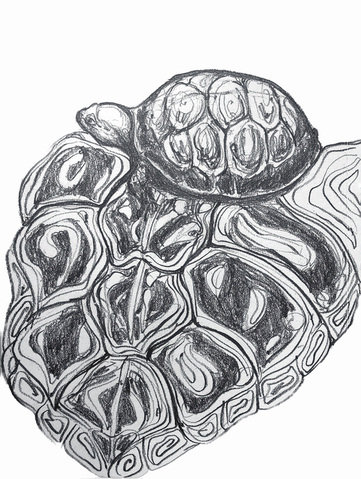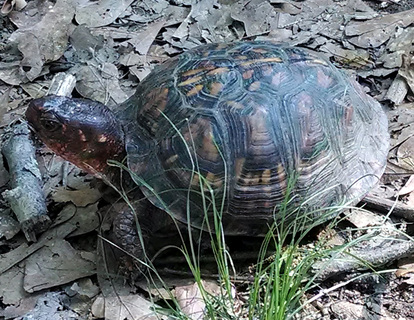
I came across this turtle in just the kind of place that a box turtle likes – between the swamp and the forest. Box turtles live in both locations. They eat just about anything they come across – small animals (insects, snails, worms), carrion (dead animals), plant parts, and more. Possibly young turtles are more carnivorous while they’re growing the most, and older turtles are more herbivorous. When threatened, box turtles draw their heads and limbs inside their shells – and this kind of turtle can even close its belly plate (called a plastron) up tight, completely sealing off all entrances to the shell. Larger predators find they can’t bite their way through the shell of a fully closed-up, mature box turtle.
It takes a box turtle 5 to 10 years to reach sexual maturity. A male box turtle will have a concave (indented) area on his plastron – this enables him to balance himself against and on top of a female’s shell while they are mating. A female turtle’s plastron is smooth in shape. Females can store fertilized eggs inside their bodies for several years before laying them. Males usually have reddish eyes, and females’ are brown. Box turtles can live for 100 years or more.

If you find a box turtle that is crossing a busy road where it could easily get run over, you could help it out by taking it to the other side of the road – if it is really clear which direction it was trying to go. At the Phinizy Swamp, it’s best to just look at the turtle without touching it.
Box turtles reproduce themselves very slowly. Each female box turtle may end up having only 2 or 3 offspring who survive to adulthood. Although box turtles are very successful at defending themselves against would-be predators, their greatest current danger is from humans.
For more information on visiting the Phinizy Swamp, see the site for the Southeastern Natural Sciences Academy:
http://naturalsciencesacademy.org/
 RSS Feed
RSS Feed